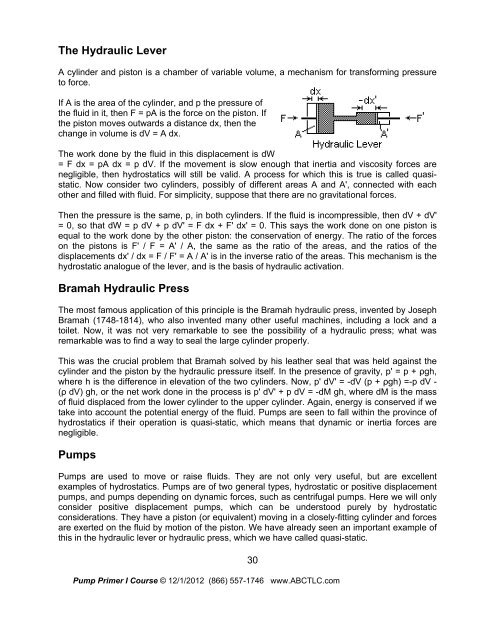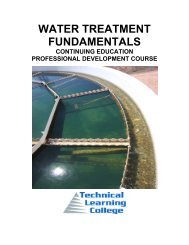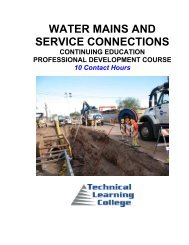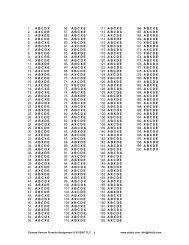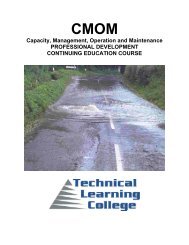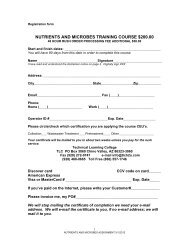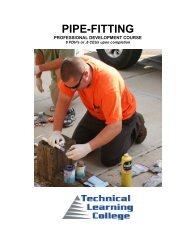Pump Primer 1 $100 - 8 Hours - Technical Learning College
Pump Primer 1 $100 - 8 Hours - Technical Learning College
Pump Primer 1 $100 - 8 Hours - Technical Learning College
Create successful ePaper yourself
Turn your PDF publications into a flip-book with our unique Google optimized e-Paper software.
The Hydraulic Lever<br />
A cylinder and piston is a chamber of variable volume, a mechanism for transforming pressure<br />
to force.<br />
If A is the area of the cylinder, and p the pressure of<br />
the fluid in it, then F = pA is the force on the piston. If<br />
the piston moves outwards a distance dx, then the<br />
change in volume is dV = A dx.<br />
The work done by the fluid in this displacement is dW<br />
= F dx = pA dx = p dV. If the movement is slow enough that inertia and viscosity forces are<br />
negligible, then hydrostatics will still be valid. A process for which this is true is called quasistatic.<br />
Now consider two cylinders, possibly of different areas A and A', connected with each<br />
other and filled with fluid. For simplicity, suppose that there are no gravitational forces.<br />
Then the pressure is the same, p, in both cylinders. If the fluid is incompressible, then dV + dV'<br />
= 0, so that dW = p dV + p dV' = F dx + F' dx' = 0. This says the work done on one piston is<br />
equal to the work done by the other piston: the conservation of energy. The ratio of the forces<br />
on the pistons is F' / F = A' / A, the same as the ratio of the areas, and the ratios of the<br />
displacements dx' / dx = F / F' = A / A' is in the inverse ratio of the areas. This mechanism is the<br />
hydrostatic analogue of the lever, and is the basis of hydraulic activation.<br />
Bramah Hydraulic Press<br />
The most famous application of this principle is the Bramah hydraulic press, invented by Joseph<br />
Bramah (1748-1814), who also invented many other useful machines, including a lock and a<br />
toilet. Now, it was not very remarkable to see the possibility of a hydraulic press; what was<br />
remarkable was to find a way to seal the large cylinder properly.<br />
This was the crucial problem that Bramah solved by his leather seal that was held against the<br />
cylinder and the piston by the hydraulic pressure itself. In the presence of gravity, p' = p + ρgh,<br />
where h is the difference in elevation of the two cylinders. Now, p' dV' = -dV (p + ρgh) =-p dV -<br />
(ρ dV) gh, or the net work done in the process is p' dV' + p dV = -dM gh, where dM is the mass<br />
of fluid displaced from the lower cylinder to the upper cylinder. Again, energy is conserved if we<br />
take into account the potential energy of the fluid. <strong>Pump</strong>s are seen to fall within the province of<br />
hydrostatics if their operation is quasi-static, which means that dynamic or inertia forces are<br />
negligible.<br />
<strong>Pump</strong>s<br />
<strong>Pump</strong>s are used to move or raise fluids. They are not only very useful, but are excellent<br />
examples of hydrostatics. <strong>Pump</strong>s are of two general types, hydrostatic or positive displacement<br />
pumps, and pumps depending on dynamic forces, such as centrifugal pumps. Here we will only<br />
consider positive displacement pumps, which can be understood purely by hydrostatic<br />
considerations. They have a piston (or equivalent) moving in a closely-fitting cylinder and forces<br />
are exerted on the fluid by motion of the piston. We have already seen an important example of<br />
this in the hydraulic lever or hydraulic press, which we have called quasi-static.<br />
<strong>Pump</strong> <strong>Primer</strong> I Course © 12/1/2012 (866) 557-1746 www.ABCTLC.com<br />
30


